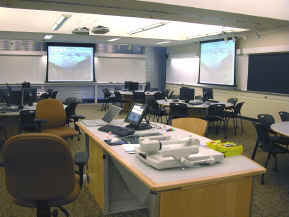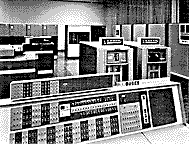The Archeology of Building 26
-
-
slice.mit.edu
- 6
Filed Under
Recommended
 Professor Patrick Henry Winston ’65, SM ’67, PhD ’70
Professor Patrick Henry Winston ’65, SM ’67, PhD ’70A day or two ago, I explained the state of Artificial Intelligence to a group of high school teachers here for the 2012 edition of the MIT Science and Engineering Program for Teachers (STEP), where high school teachers learn about what's new.
I've been part of the program for the past twenty years or so. I think of it as payback for the inspiration I got from my high school physics teacher, Mr. Smith, and my high school algebra teacher, Mr. Gerlach, affectionately known to us students as “Snuffy” and “Hogjaws.” I never got around to thanking them, so I thank each batch of STEP teachers instead.*
My talk was in 26-152, now a room converted to Technology Enhanced Active Learning (TEAL), where students sit at tables and work together to absorb material and solve problems.
It occurred to me that if I stripped off the carpet, I would likely see signs of false floor, because when I showed up at MIT, 26-152 was the home of the IBM 7090, the wonder of its age.
Back then, 26-152 was like a tabernacle. Only priests, also known as operators, were allowed in. Lights blinked. Big tape drives spun. Air conditioners made noise and spewed cold air. Card readers ate card decks by the yard. Important, pioneering programs executed, including the very first AI program that performed at a human level.
Freshmen, like me, would stop at the glass doors and stare in, mesmerized.
MIT's 7090 had two memories, one for user programs and one for the time-sharing system, both holding 32k words of 36 bits each. So, the 7090 had a little more than 256KB of memory.
I asked the teachers to pull out their iPhones. I noted that each one has more than 100,000 times more memory than the 7090.
If tuition had increased by 100,000 times, MIT would cost $140 million per year. If my laser pointer had 100,000 times more power, I could cut through a half-inch of steel.
Amazing.
* I have long regretted that I never sent a thank-you note to Snuffy or Hogjaws. If someone inspired you back in high school, I know it would make their day, or maybe their year, to hear from you.









Comments
Barry Cunningham
Sun, 07/01/2012 2:50pm
I took my first programming course in June-July, 1966 at UCLA where we used 7094 assembly language. That (and 6.251 in Spring, 1967) are why I remember the word-length. By the time I got to MIT in September, 1966, 26-152 held 2 7094s, with 14 1401s feeding them data from a host of tape drives and card readers so they wouldn't have to wait on I/O from such slow peripherals.
Some years later, I recall it being the Physics Reading Room (or some such). And, it was a very comfortable reading room, with very plush, comfy leather chairs.
Dave Tuttle
Fri, 10/30/2015 5:18pm
Well, Barry -- You almost had it right. I started hanging around the machines in Building 26 at the time you mention. I was a member of the Class of 1970. The CTSS machine was a custom IBM 7094 with dual memory units, but it was just one processor. The custom modifications (by IBM, at MIT's request) allowed the CTSS 'kernel' [an unknown word, at the time] to run IBSYS batch jobs in one memory space and swap the processor to interactive user jobs in the other memory when there was something to do. Courtesy of a woman who worked for me some years later, I have a copy of a WGBH Science Reporter program from 1963 that shows and explains the concept of "Time Sharing" on that machine.
Anne V. Williams
Mon, 07/02/2012 1:52pm
Remember the line printers? Yeeks. what a racket they made.
Michael Bates '86
Mon, 07/02/2012 11:36am
I guess I was too late to see the 7090, and I was there before the TEAL, but I remember the Physics Sleeping Room and its comfy leather chairs with gratitude. (I also remember Prof. Winston's lecture on lecturing heuristics with gratitude.)
Patrick
Sun, 07/01/2012 10:34am
Right, I was approximating. Fixed.
Barry Cunningham
Sun, 07/01/2012 10:07am
The 7090 had a 36-bit word length; bytes weren't available yet.